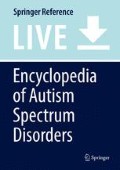References and Reading
American Psychiatric Association. (2013). Diagnostic and statistical manual of mental disorders: DSM-5 (5th ed.). Washington, DC: American Psychiatric Association.
Anderson-Hanley, C., Tureck, K., & Schneiderman, R. L. (2011). Autism and exergaming: Effects on repetitive behaviors and cognition. Psychology Research and Behavior Management, 4, 129–137.
Baron-Cohen, S., Wheelwright, S., Hill, J., Raste, Y., & Plumb, I. (2001). The “Reading the mind in the eyes” test revised version: A study with normal adults, and adults with Asperger syndrome or high-functioning autism. Journal of Child Psychology and Psychiatry, 42, 241–251.
Bellani, M., Fornasari, L., Chittaro, L., & Brambilla, P. (2011). Virtual reality in autism: State of the art. Epidemiology and Psychiatric Sciences, 20, 235–238.
Bohil, C. J., Alicea, B., & Biocca, F. A. (2011). Virtual reality in neuroscience research and therapy. Nature Reviews. Neuroscience, 12, 752–762.
Eikeseth, S. (2009). Outcome of comprehensive psycho-educational interventions for young children with autism. Research in Developmental Disabilities, 30, 158–178.
Elwyn, G., Edwards, A., Kinnersley, P., & Grol, R. (2000). Shared decision making and the concept of equipoise: The competences of involving patients in healthcare choices. British Journal of General Practice, 50, 892–899.
Ghanouni, P., Jarus, T., Zwicker, J., Lucyshyn, G., Chauhan, J., & Moir, S. (2019). Perceived barriers and existing challenges in participation of children with autism Spectrum disorders: “He did not understand and no one Else seemed to understand him”. Journal of Autism and Developmental Disorders, 49, 3136–3145.
Golan, O., Ashwin, E., Granader, Y., McClintock, S., Day, K., Leggett, V., & Baron-Cohen, S. (2010). Enhancing emotion recognition in children with autism spectrum conditions: An intervention using animated vehicles with real emotional faces. Journal of Autism and Developmental Disorders, 40, 269–279.
Guadagnoli, E., & Ward, P. (1998). Patient participation in decision-making. Social Science & Medicine, 47, 329–339.
Hopkins, I. M., Gower, M. W., Perez, T. A., Smith, D. S., Amthor, F. R., Wimsatt, F. C., & Biasini, F. J. (2011). Avatar assistant: Improving social skills in students with an ASD through a computer-based intervention. Journal of Autism and Developmental Disorders, 41, 1543–1555.
Hughes, D. E. (2014). The design and evaluation of a video game to help train perspective-taking and empathy in children with autism spectrum disorder. Orlando: University of Central Florida.
Kelly, A., Garnett, M., Attwood, T., & Peterson, C. (2008). Autism spectrum symptomology in children: The impact of family and peer relationships. Journal of Abnormal Child Psychology, 36, 1069–1108.
Lopata, C., Volker, M. A., Putnam, S. K., Thomeer, M. L., & Nida, R. E. (2008). Effect of social familiarity on salivary cortisol and self-reports of social anxiety and stress in children with high functioning autism spectrum disorders. Journal of Autism and Developmental Disorders, 38, 1866–1877.
Matson, J. L., & Smith, K. R. (2008). Current status of intensive behavioral interventions for young children with autism and PDD-NOS. Research in Autism Spectrum Disorders, 2, 60–74.
Mesa-Gresa, P., Gil-Gómez, H., Lozano-Quilis, J.-A., & Gil-Gómez, J.-A. (2018). Effectiveness of virtual reality for children and adolescents with autism Spectrum disorder: An evidence-based systematic review. Sensors, 18, 2486.
Montes, G. (2015). Children with autism spectrum disorder and screen time: Results from a large, nationally representative US study. Academic Pediatrics, 16, 122–128.
Moore, D., McGrath, P., & Thorpe, J. (2000). Computer-aided learning for people with autism–a framework for research and development. Innovations in Education and Teaching International, 37, 218–228.
Parsons, S., & Cobb, S. (2011). State-of-the-art of virtual reality technologies for children on the autism spectrum. European Journal of Special Needs Education, 26, 355–366.
Simonoff, E., Pickles, A., Charman, T., Chandler, S., Loucas, T., & Baird, G. (2008). Psychiatric disorders in children with autism spectrum disorders: Prevalence, comorbidity, and associated factors in a population-derived sample. Journal of the American Academy of Child & Adolescent Psychiatry, 47, 921–929.
Tanaka, J. W., Wolf, J. M., Klaiman, C., Koenig, K., Cockburn, J., Herlihy, L., … Schultz, R. T. (2010). Using computerized games to teach face recognition skills to children with autism spectrum disorder: The Let’s face it! Program. Journal of Child Psychology and Psychiatry, 51, 944–952.
Wang, X., Laffey, J., Xing, W., Galyen, K., & Stitcher, J. (2017). Fostering verbal and non-verbal social interactions in a 3D collaborative virtual learning environment: a case study of youth with autism spectrum disorders learning social competence in iSocial. Education Technology Research Development, 65, 1015–1039.
Weber, R., Ritterfeld, U., & Mathiak, K. (2006). Does playing violent video games induce aggression? Empirical evidence of a functional magnetic resonance imaging study. Media Psychology, 8, 39–60.
Wilczynski, S. M., Menousek, K., Hunter, M., & Mudgal, D. (2007). Individualized education programs for youth with autism spectrum disorders. Psychology in the Schools, 44, 653–666.
Author information
Authors and Affiliations
Corresponding author
Editor information
Editors and Affiliations
Rights and permissions
Copyright information
© 2020 Crown
About this entry
Cite this entry
Ghanouni, P. (2020). Gaming Technologies in Rehabilitation of Individuals with Autism. In: Volkmar, F. (eds) Encyclopedia of Autism Spectrum Disorders. Springer, New York, NY. https://doi.org/10.1007/978-1-4614-6435-8_102474-1
Download citation
DOI: https://doi.org/10.1007/978-1-4614-6435-8_102474-1
Received:
Accepted:
Published:
Publisher Name: Springer, New York, NY
Print ISBN: 978-1-4614-6435-8
Online ISBN: 978-1-4614-6435-8
eBook Packages: Springer Reference Behavioral Science and PsychologyReference Module Humanities and Social SciencesReference Module Business, Economics and Social Sciences

